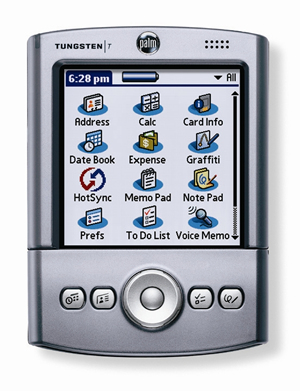Inside Palm OS 5


It’s immediately apparent that Palm OS 5 is not going to radically alter anybody’s PIM experience, or blow the socks off current Palm owners and encourage them to upgrade lest they get left behind. But it does take some steps that many would say are long overdue. Its key feature is support for ARM-compliant processors, at last allowing hardware manufacturers to dump Motorola’s slow Dragonball chip in favour of something more capable.
Compatibility
Potential upgraders do not need to worry about compatibility. The official word is that if users of older Palm devices choose to upgrade their hardware to take advantage of ARM compliance they’ll find most of their current applications should run. PalmSource can’t vouch for every single application, though. Some programs deliberately incorporate operating system workarounds to deliver performance improvements, and these scupper the compliance routines. But PalmSource does claim performance improvements for existing applications of up to 300 percent. There may be visual enhancements too, as Palm OS 5 supports the 320 by 320 screen resolution that Sony has exploited in its CLIE range.
Other new features include support for SSL (Secure Socket Layer) encryption to enable secure Web browsing and online transactions, plus support for sound recording and playback. This is key, given that Pocket PC’s Media Player is an alluring OS-level feature. Sony managed to include an MP3 player with some of its Palm OS 4 CLIE range, so it’s odd that the first OS 5 device, Palm’s Tungsten T, fails to bundle a player.
Wireless support
Palm OS 5 also adds support for 802.11b to the Bluetooth and infrared wireless technologies previously catered for. PalmSource clearly remains committed to wireless networking, and does not want to fall further behind Pocket PC than it already is in supporting this technology, which it sees as vital for success in the corporate world. Indeed, Nagel expressed frustration at corporate endorsement of the Pocket PC platform, noting that devices used at work are inevitably also used at home, and that given time corporate decisions can squeeze the non-selected operating system out of the frame entirely.
Interface
The changes apparent in OS 5 are very much behind the scenes. Little has altered as far as general looks are concerned. Hold a Palm OS 5 device such as the Tungsten T in your hand, and the home screen is peppered with familiar icons. Menus drop down in the usual way, applications are categorised into familiar groupings (Games, Main, System, Utilities, Unfiled), and so on. The inference is that PalmSource is building on an already successful platform, and if it isn’t broken, there’s no real need to fix it.
An alternative take suggests that PalmSource is stuck between a rock and a hard place. Pocket PC, currently Palm’s main rival, is an all-singing, all-dancing operating system, capable of manifold multimedia feats, and PalmSource has to either catch up fast or admit that it wants to pursue a different market. Currently it seems reluctant to do either.
Palm-reading
David Nagel was, naturally, keen to accentuate the positive in his presentation. His highlights included noting that over 2.5 million Palm devices have been shipped, most of them in the last three years. Given that the replacement cycle for a handheld seems to be around 2-3 years, Nagel concluded that around 20 million Palms are in use around the globe. He is proud of a developer community numbering around 240,000 and growing at a rate or two or three thousand a week. And he was bullish about the threat from the likes of Dell, which is about to enter the Pocket PC arena with a low-cost device.
All fine and good, but PalmSource has to compete with its rivals if it’s going to exist in two or three years’ time. In this respect, perhaps the most interesting aspects of Palm OS 5 are not the enhancements, but the way it is marketed to hardware partners, and the development strategy. In the former case, PalmSource is clear that it does not have a long list of reference design requirements. Pocket PC’s requirements, which are quite specific in a number of hardware respects, have, says Nagel, been at least partly responsible for the similarity of design of much Pocket PC hardware. Palm OS hardware, by contrast, varies widely, and Nagel hinted that OEM partners soon to be announced will add even more variety.
In the case of operating system development, Nagel claims an open source-like attitude, with third parties able to add their own elements to the operating system, feeding these back to PalmSource for inclusion in later releases. It is his belief that this provides for the widest possible development reach.